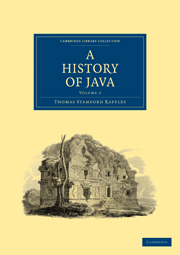Summary
Amongst the various traditions regarding the manner in which Java and the Eastern Islands were originally peopled, and the source whence its population proceeded, it has been related, that the first inhabitants came in vessels from the Red Sea (Láut Míra), and that, in their passage, they coasted along the shores of Hindustan; that peninsula then forming an unbroken continent with the land in the Indian Archipelago, from which it is now so widely separated, and which, according to the tradition, has since been divided into so many distinct islands, by some convulsions of nature or revolution of the elements.
These people are supposed to have been banished from Egypt, and to have consisted of individuals professing different religious persuasions, who carried along with them to the land of their exile, their different modes of worship and articles of belief. Some are said to have adored the sun, others the moon; some the elements of fire or water, and others the trees of the forest. Like all other uncivilized men, they were addicted to the arts of divination, and particularly to the practice of astrology. In other respects, they are described as savages, living in hordes, without fixed habitations, without the protection of regular government, or the restraint of established law. Respect for age was the only substitute for civil obedience. The oldest man of the horde was considered its chief, and regulated its simple movements, or prescribed its political duties.
- Type
- Chapter
- Information
- A History of Java , pp. 65 - 134Publisher: Cambridge University PressPrint publication year: 2010First published in: 1817



